New Zealand Milk Production Update – Sep ’16
Executive Summary
New Zealand milk production figures provided by Dairy Companies Association of New Zealand (DCANZ) were recently updated with values spanning through Aug ’16. Highlights from the updated report include:
• New Zealand milk production volumes increased from the recently experienced seasonal lows but finished down 2.7% on a YOY basis during Aug ’16. Production volumes will continue to increase seasonally until highs are reached during the month of October.
• ’16-’17 New Zealand farmgate milk price projections were raised by a total of $1.00/kgMS throughout the past two months to a value of $5.25/kgMS but remain near estimated breakeven levels.
• New Zealand cow & heifer slaughter rates reached a record annual high during the ’15-’16 production season but have finished 1.8% lower on a YOY basis throughout the first quarter of the ’16-’17 production season. New Zealand cow & heifer slaughter rates declined by 11.8% YOY during Aug ’16.
Additional Report Details
According to DCANZ, Aug ’16 New Zealand milk production volumes increased to a four month high seasonally but finished lower on a YOY basis, declining by 2.7%. New Zealand milk production typically reaches seasonal lows during the months of June and July as farmers dry off their herds in preparation for spring calving before increasing production volumes until seasonal highs are reached during the month of October.
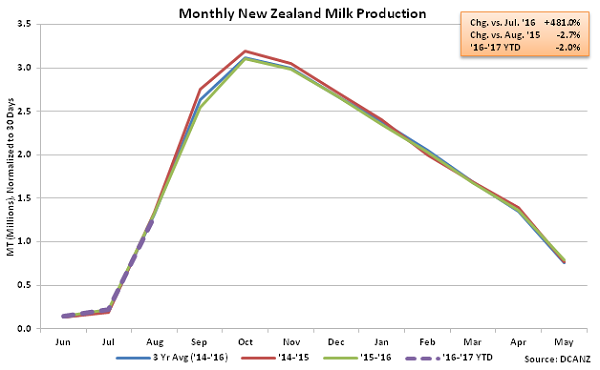 Despite warnings of an El Niño event potentially resulting in dry conditions across New Zealand, better than anticipated growing conditions resulted in only moderate YOY declines in milk production over the second half of the ’15-’16 production season. ’15-’16 annual New Zealand milk production finished down just 1.9%, significantly less than Fonterra’s Mar ’16 projected annual YOY decline in milk collections of 4.0%.
Despite warnings of an El Niño event potentially resulting in dry conditions across New Zealand, better than anticipated growing conditions resulted in only moderate YOY declines in milk production over the second half of the ’15-’16 production season. ’15-’16 annual New Zealand milk production finished down just 1.9%, significantly less than Fonterra’s Mar ’16 projected annual YOY decline in milk collections of 4.0%.
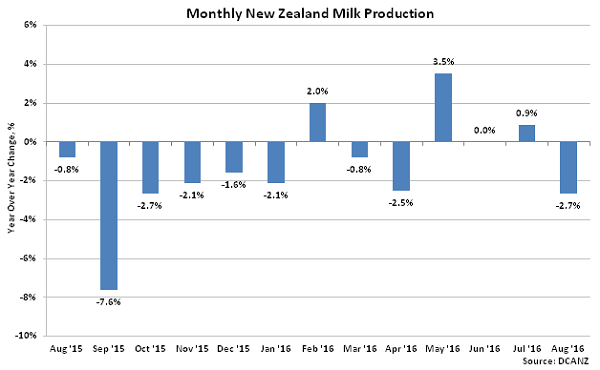 Timely rainfall was experienced across the majority of New Zealand during the early months of 2016, reducing seasonally higher than average soil moisture deficits experienced in late 2015. More recently, Aug ’16 New Zealand rainfall declined to a five year low for the month of August when weighted based on levels of regional milk production.
Timely rainfall was experienced across the majority of New Zealand during the early months of 2016, reducing seasonally higher than average soil moisture deficits experienced in late 2015. More recently, Aug ’16 New Zealand rainfall declined to a five year low for the month of August when weighted based on levels of regional milk production.
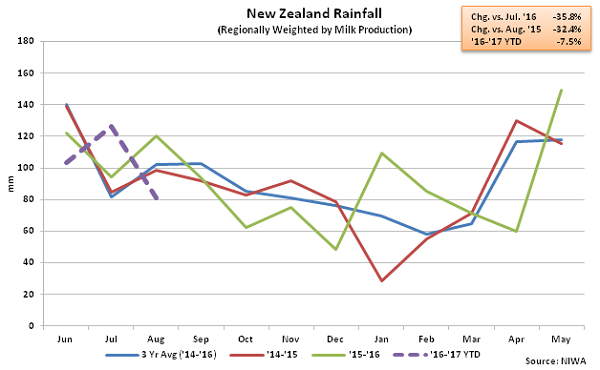 Lower than average New Zealand rainfall levels contributed to soil moisture deficits finishing higher on a YOY basis over four consecutive months through Aug ’16. New Zealand soil moisture deficits remain near seasonal lows typically experienced throughout the Southern Hemisphere’s winter months, however.
Lower than average New Zealand rainfall levels contributed to soil moisture deficits finishing higher on a YOY basis over four consecutive months through Aug ’16. New Zealand soil moisture deficits remain near seasonal lows typically experienced throughout the Southern Hemisphere’s winter months, however.
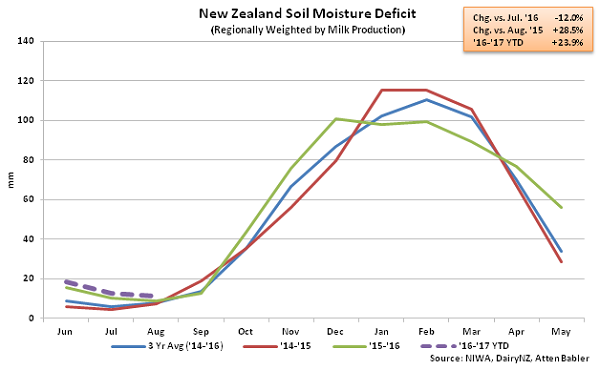 New Zealand soil moisture deficits increase seasonally until highs are typically reached during the months of January and February, simultaneously with New Zealand air temperatures. Air temperatures also finished higher on a YOY basis for the fourth consecutive month during Aug ’16 but remain near seasonal lows.
New Zealand soil moisture deficits increase seasonally until highs are typically reached during the months of January and February, simultaneously with New Zealand air temperatures. Air temperatures also finished higher on a YOY basis for the fourth consecutive month during Aug ’16 but remain near seasonal lows.
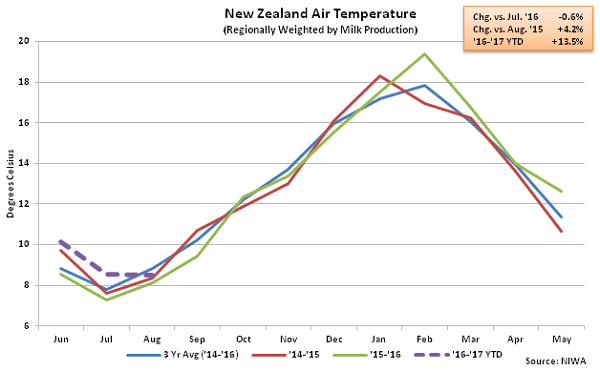 Warmer than normal temperatures typically occur over much of New Zealand during La Niña events, historically. The National Oceanic and Atmospheric Administration Oceanic Niño Index and Multivariate ENSO Index, measures used to identify the intensity of El Niño and La Niña events, have each declined significantly from 17 year highs experienced during 2015 and are approaching levels indicative of a developing La Niña event. La Niña events typically result in wet conditions across much of New Zealand and subsequent declines in soil moisture deficits.
Warmer than normal temperatures typically occur over much of New Zealand during La Niña events, historically. The National Oceanic and Atmospheric Administration Oceanic Niño Index and Multivariate ENSO Index, measures used to identify the intensity of El Niño and La Niña events, have each declined significantly from 17 year highs experienced during 2015 and are approaching levels indicative of a developing La Niña event. La Niña events typically result in wet conditions across much of New Zealand and subsequent declines in soil moisture deficits.
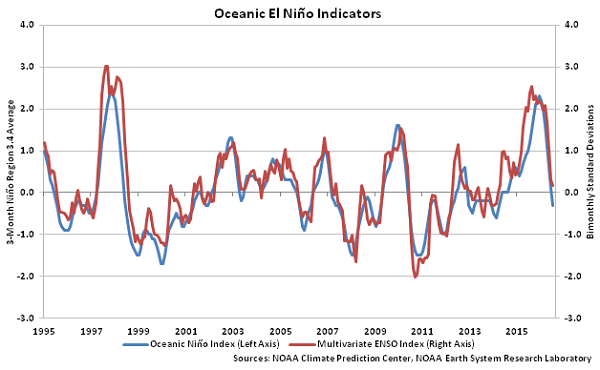 New Zealand farmgate milk prices reached a nine year low during the ’15-’16 production season as concerns over a potential El Niño event mounted while global milk supplies expanded significantly, particularly from within the EU-28. More recently, the ’16-’17 farmgate milk price forecast was increased by a total of $1.00/kgMS to a value of $5.25/kgMS as continued reductions in milk supply are expected to bring global supply and demand back into balance. The ’16-’17 forecasted milk price remains near estimated breakeven price levels, however, which could result in continued culling and pullbacks in production levels.
New Zealand farmgate milk prices reached a nine year low during the ’15-’16 production season as concerns over a potential El Niño event mounted while global milk supplies expanded significantly, particularly from within the EU-28. More recently, the ’16-’17 farmgate milk price forecast was increased by a total of $1.00/kgMS to a value of $5.25/kgMS as continued reductions in milk supply are expected to bring global supply and demand back into balance. The ’16-’17 forecasted milk price remains near estimated breakeven price levels, however, which could result in continued culling and pullbacks in production levels.
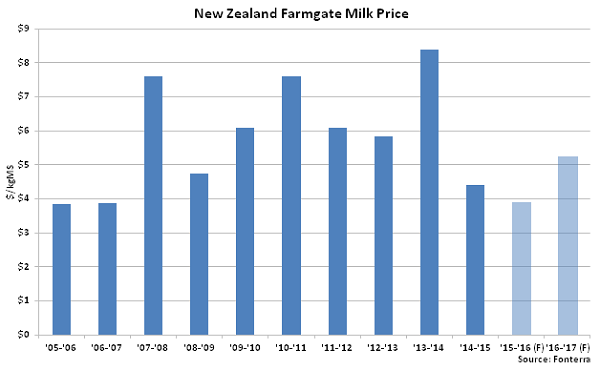 New Zealand slaughter rates accelerated during the final months of the ’15-’16 production season, reaching record seasonal highs. Overall, ’15-’16 annual New Zealand cow & heifer slaughter rates finished up 3.2% YOY, reaching a record annual high. New Zealand cow & heifer slaughter rates have declined by 1.8% in total over the first quarter of the ’16-’17 production season, however, as a 11.8% YOY decline in slaughter rates was experienced during Aug ’16.
New Zealand slaughter rates accelerated during the final months of the ’15-’16 production season, reaching record seasonal highs. Overall, ’15-’16 annual New Zealand cow & heifer slaughter rates finished up 3.2% YOY, reaching a record annual high. New Zealand cow & heifer slaughter rates have declined by 1.8% in total over the first quarter of the ’16-’17 production season, however, as a 11.8% YOY decline in slaughter rates was experienced during Aug ’16.
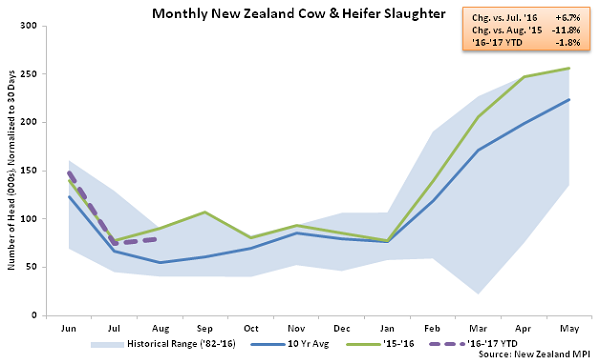
 Despite warnings of an El Niño event potentially resulting in dry conditions across New Zealand, better than anticipated growing conditions resulted in only moderate YOY declines in milk production over the second half of the ’15-’16 production season. ’15-’16 annual New Zealand milk production finished down just 1.9%, significantly less than Fonterra’s Mar ’16 projected annual YOY decline in milk collections of 4.0%.
Despite warnings of an El Niño event potentially resulting in dry conditions across New Zealand, better than anticipated growing conditions resulted in only moderate YOY declines in milk production over the second half of the ’15-’16 production season. ’15-’16 annual New Zealand milk production finished down just 1.9%, significantly less than Fonterra’s Mar ’16 projected annual YOY decline in milk collections of 4.0%.
 Timely rainfall was experienced across the majority of New Zealand during the early months of 2016, reducing seasonally higher than average soil moisture deficits experienced in late 2015. More recently, Aug ’16 New Zealand rainfall declined to a five year low for the month of August when weighted based on levels of regional milk production.
Timely rainfall was experienced across the majority of New Zealand during the early months of 2016, reducing seasonally higher than average soil moisture deficits experienced in late 2015. More recently, Aug ’16 New Zealand rainfall declined to a five year low for the month of August when weighted based on levels of regional milk production.
 Lower than average New Zealand rainfall levels contributed to soil moisture deficits finishing higher on a YOY basis over four consecutive months through Aug ’16. New Zealand soil moisture deficits remain near seasonal lows typically experienced throughout the Southern Hemisphere’s winter months, however.
Lower than average New Zealand rainfall levels contributed to soil moisture deficits finishing higher on a YOY basis over four consecutive months through Aug ’16. New Zealand soil moisture deficits remain near seasonal lows typically experienced throughout the Southern Hemisphere’s winter months, however.
 New Zealand soil moisture deficits increase seasonally until highs are typically reached during the months of January and February, simultaneously with New Zealand air temperatures. Air temperatures also finished higher on a YOY basis for the fourth consecutive month during Aug ’16 but remain near seasonal lows.
New Zealand soil moisture deficits increase seasonally until highs are typically reached during the months of January and February, simultaneously with New Zealand air temperatures. Air temperatures also finished higher on a YOY basis for the fourth consecutive month during Aug ’16 but remain near seasonal lows.
 Warmer than normal temperatures typically occur over much of New Zealand during La Niña events, historically. The National Oceanic and Atmospheric Administration Oceanic Niño Index and Multivariate ENSO Index, measures used to identify the intensity of El Niño and La Niña events, have each declined significantly from 17 year highs experienced during 2015 and are approaching levels indicative of a developing La Niña event. La Niña events typically result in wet conditions across much of New Zealand and subsequent declines in soil moisture deficits.
Warmer than normal temperatures typically occur over much of New Zealand during La Niña events, historically. The National Oceanic and Atmospheric Administration Oceanic Niño Index and Multivariate ENSO Index, measures used to identify the intensity of El Niño and La Niña events, have each declined significantly from 17 year highs experienced during 2015 and are approaching levels indicative of a developing La Niña event. La Niña events typically result in wet conditions across much of New Zealand and subsequent declines in soil moisture deficits.
 New Zealand farmgate milk prices reached a nine year low during the ’15-’16 production season as concerns over a potential El Niño event mounted while global milk supplies expanded significantly, particularly from within the EU-28. More recently, the ’16-’17 farmgate milk price forecast was increased by a total of $1.00/kgMS to a value of $5.25/kgMS as continued reductions in milk supply are expected to bring global supply and demand back into balance. The ’16-’17 forecasted milk price remains near estimated breakeven price levels, however, which could result in continued culling and pullbacks in production levels.
New Zealand farmgate milk prices reached a nine year low during the ’15-’16 production season as concerns over a potential El Niño event mounted while global milk supplies expanded significantly, particularly from within the EU-28. More recently, the ’16-’17 farmgate milk price forecast was increased by a total of $1.00/kgMS to a value of $5.25/kgMS as continued reductions in milk supply are expected to bring global supply and demand back into balance. The ’16-’17 forecasted milk price remains near estimated breakeven price levels, however, which could result in continued culling and pullbacks in production levels.
 New Zealand slaughter rates accelerated during the final months of the ’15-’16 production season, reaching record seasonal highs. Overall, ’15-’16 annual New Zealand cow & heifer slaughter rates finished up 3.2% YOY, reaching a record annual high. New Zealand cow & heifer slaughter rates have declined by 1.8% in total over the first quarter of the ’16-’17 production season, however, as a 11.8% YOY decline in slaughter rates was experienced during Aug ’16.
New Zealand slaughter rates accelerated during the final months of the ’15-’16 production season, reaching record seasonal highs. Overall, ’15-’16 annual New Zealand cow & heifer slaughter rates finished up 3.2% YOY, reaching a record annual high. New Zealand cow & heifer slaughter rates have declined by 1.8% in total over the first quarter of the ’16-’17 production season, however, as a 11.8% YOY decline in slaughter rates was experienced during Aug ’16.
